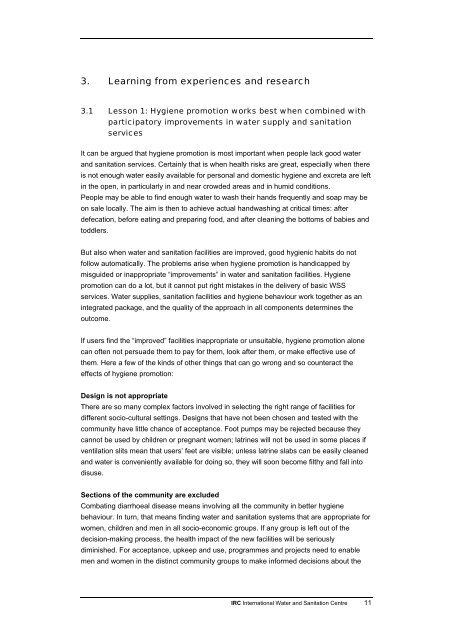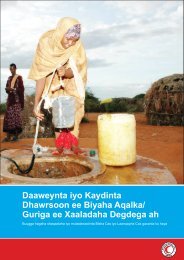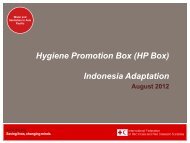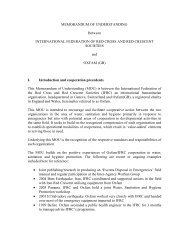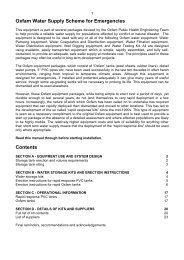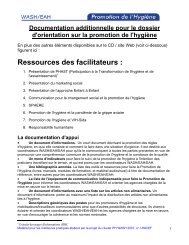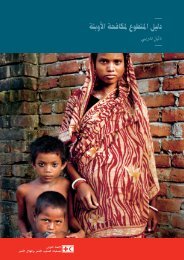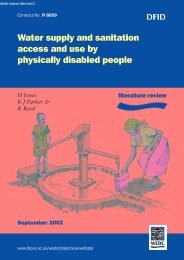Hygiene Promotion - IRC International Water and Sanitation Centre
Hygiene Promotion - IRC International Water and Sanitation Centre
Hygiene Promotion - IRC International Water and Sanitation Centre
You also want an ePaper? Increase the reach of your titles
YUMPU automatically turns print PDFs into web optimized ePapers that Google loves.
3. Learning from experiences <strong>and</strong> research3.1 Lesson 1: <strong>Hygiene</strong> promotion works best when combined withparticipatory improvements in water supply <strong>and</strong> sanitationservicesIt can be argued that hygiene promotion is most important when people lack good water<strong>and</strong> sanitation services. Certainly that is when health risks are great, especially when thereis not enough water easily available for personal <strong>and</strong> domestic hygiene <strong>and</strong> excreta are leftin the open, in particularly in <strong>and</strong> near crowded areas <strong>and</strong> in humid conditions.People may be able to find enough water to wash their h<strong>and</strong>s frequently <strong>and</strong> soap may beon sale locally. The aim is then to achieve actual h<strong>and</strong>washing at critical times: afterdefecation, before eating <strong>and</strong> preparing food, <strong>and</strong> after cleaning the bottoms of babies <strong>and</strong>toddlers.But also when water <strong>and</strong> sanitation facilities are improved, good hygienic habits do notfollow automatically. The problems arise when hygiene promotion is h<strong>and</strong>icapped bymisguided or inappropriate “improvements” in water <strong>and</strong> sanitation facilities. <strong>Hygiene</strong>promotion can do a lot, but it cannot put right mistakes in the delivery of basic WSSservices. <strong>Water</strong> supplies, sanitation facilities <strong>and</strong> hygiene behaviour work together as anintegrated package, <strong>and</strong> the quality of the approach in all components determines theoutcome.If users find the “improved” facilities inappropriate or unsuitable, hygiene promotion alonecan often not persuade them to pay for them, look after them, or make effective use ofthem. Here a few of the kinds of other things that can go wrong <strong>and</strong> so counteract theeffects of hygiene promotion:Design is not appropriateThere are so many complex factors involved in selecting the right range of facilities fordifferent socio-cultural settings. Designs that have not been chosen <strong>and</strong> tested with thecommunity have little chance of acceptance. Foot pumps may be rejected because theycannot be used by children or pregnant women; latrines will not be used in some places ifventilation slits mean that users’ feet are visible; unless latrine slabs can be easily cleaned<strong>and</strong> water is conveniently available for doing so, they will soon become filthy <strong>and</strong> fall intodisuse.Sections of the community are excludedCombating diarrhoeal disease means involving all the community in better hygienebehaviour. In turn, that means finding water <strong>and</strong> sanitation systems that are appropriate forwomen, children <strong>and</strong> men in all socio-economic groups. If any group is left out of thedecision-making process, the health impact of the new facilities will be seriouslydiminished. For acceptance, upkeep <strong>and</strong> use, programmes <strong>and</strong> projects need to enablemen <strong>and</strong> women in the distinct community groups to make informed decisions about the<strong>IRC</strong> <strong>International</strong> <strong>Water</strong> <strong>and</strong> <strong>Sanitation</strong> <strong>Centre</strong> 11


